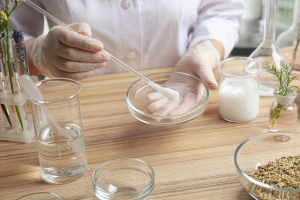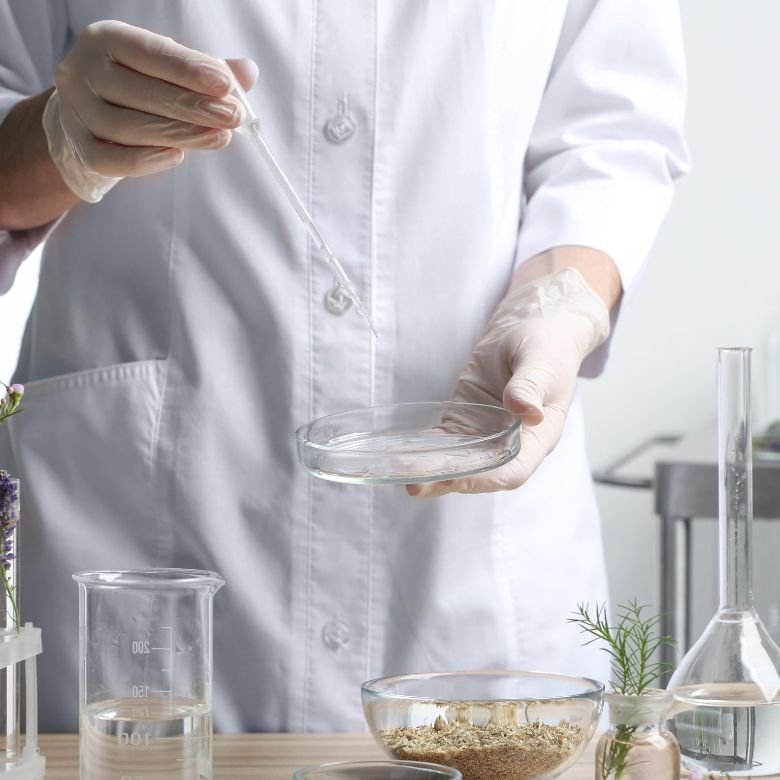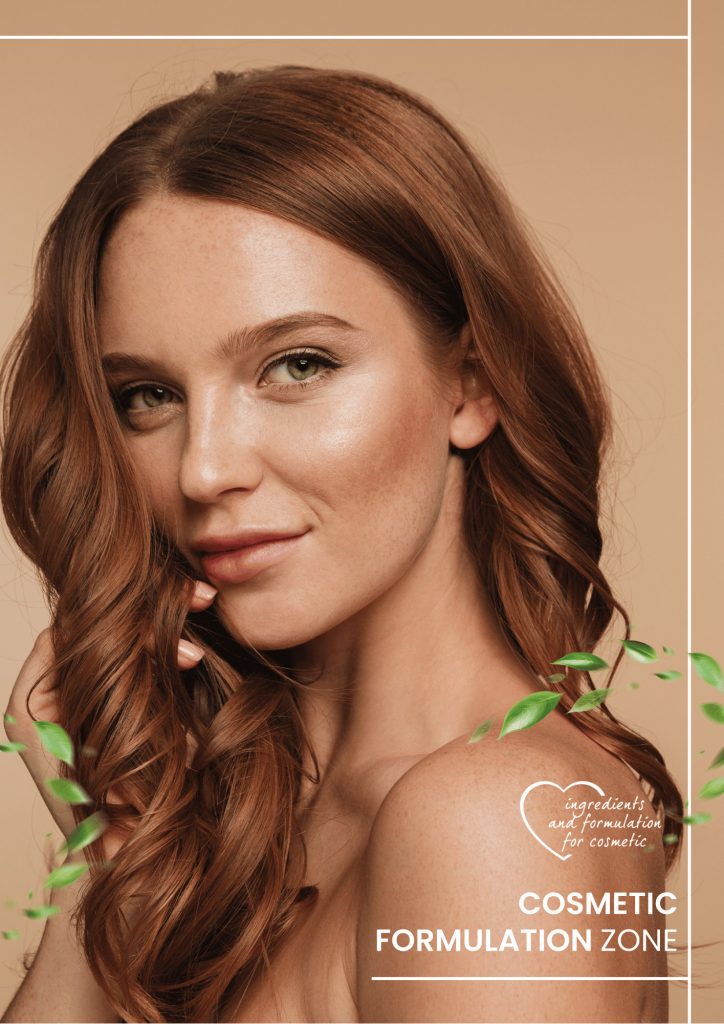Most people in the world use different types of cosmetics each day. These range from homemade natural cosmetics to products manufactured using chemical or biochemical technology or even advanced nanotechnology, etc. Where do cosmetics come from and what are different stages of their production? Let us find out!

Cosmetics – luxury goods known since antiquity
The term cosmetics is understood as preparations intended for body, face, hair and nail care. They are substances with moisturising, regenerating, beautifying, deodorising etc. effects. They were already known thousands of years ago! In the ancient civilisations of the East and West, cosmetics were luxury goods that only the wealthiest could afford.
Historically, cosmetics were mainly made from plants and minerals. Their production technology was relatively simple. Over the past millennia, there were no global or local standards for the production of cosmetics – there were only recipes passed down from generation to generation. First, raw materials were harvested and then processed by, for example, grinding, crushing and mixing. At the end of the process, the finished cosmetics were placed in clay pots, shells or leaves. Next, they were taken to the market and sold.
What does the production of cosmetics begin with?
Nowadays, the production process of cosmetics is very different to the processes from the past. Before any preparation can be placed on the market and reach the consumers, producers must meet a number of hygiene and sanitary standards. In order to be able to launch cosmetic production, the concept alone is not enough; the original recipe still needs to be developed and then tested many times.
The actual process of creating a cosmetic starts with laboratory testing and confirming the safety of the product. The manufacturer must establish sufficient technical documentation and present the properties of the preparation, including adverse reactions.
How do you produce your own cosmetics?
Over the past two decades, interest in natural cosmetics has grown significantly in Poland. More and more people want to produce them at home or in small local manufactures – read: how to make homemade cosmetics?. How do you produce your own cosmetics? First, you develop a recipe. It is usually a painstaking process, based on trial and error and involving testing of the quality as well as the performance of the cosmetic multiple times.
Once the recipe is ready, the actual production stage, packing of the cosmetics, and labelling begins. Depending on the scale of the project, manufacturers use their own or rented production lines. The premises where cosmetics are manufactured should, of course, meet cleanliness standards and the principles of Good Manufacturing Practice (GMP). Additionally, dedicated mixing equipment is needed to properly homogenise and mix the selected components and give a homogeneous mass. This process is crucial for the entire production, as meeting the customer’s expectations and relevant standards depends on it.
The first stage in the production of a cosmetic is actually finding the raw materials that you need: active substances, emollients, preservatives and other ingredients, as well as planning their supply and designing the packaging (See also: cosmetic ingredients). Unfortunately, it is often the case that the substances needed are not readily available on the Polish market, which increases their shipping time. In addition, it is crucial to carefully check their expiry dates and required storage conditions in order to best plan their storage to maximally prolong their usability.
The final part of the manufacturing process is the filling of an appropriate packaging with the cosmetic formulation, and then labelling and packing of batches of products. At this stage, a wide variety of devices are used, such as dosing and bottling machines, tube fillers, sealing machines or labellers. No stage in the production of cosmetics is easy, including labelling and packaging. In an age when thousands of products available on every shop shelf, it is essential to prepare labels and packaging that are pleasing to the eye to attract customers.
Step-by-step cream production
Among the world’s most popular cosmetics are various creams with moisturising, restorative, protective effects, etc. How are these popular cosmetics made?
In the first phase of production, investors and manufacturers develop the business project and a cream recipe with specific properties. Next, the best ingredients for the cream, including humectants, stabilisers, preservatives, fragrances and so on, are selected. The lab technicians meticulously analyse what the ideal proportions and composition of the formulation should be. Once the final recipe is ready, the production line can be started.
Creams are produced in stages, by gradually combining an aqueous solution with oily substances. This is the so-called emulsification phase, in which a homogeneous mass of a specific consistency is formed. In subsequent stages, specific additives such as fragrance oils, vitamins or minerals are gradually incorporated into the cream. The next step in the production of the creams is the assessment of their quality and acidity. The finished product is placed in packaging and is distributed to wholesalers or other customers.
Where do you acquire chemical raw materials and ingredients for your cosmetics?
Anyone who intends to start producing cosmetics should know that their quality depends largely on the quality of the raw materials from which they are made. Where is the best place to source intermediates for your cosmetics? Always purchase professional chemicals directly from reputable manufacturers such as the PCC Group or from wholesalers. Choose companies that have national and international quality certificates and are Good Manufacturing Practices as well as Good Hygiene Practices certified.
You can also find high-quality ingredients for creams, gels or soaps in on-line shops. When choosing on-line suppliers, always check their reliability carefully. Make sure that the raw materials you order have quality certificates and other certificates such as: Cruelty Free, GMO Free or Not Tested Od Animals.
Do you plan to produce natural, organic cosmetics? When looking for suppliers, always check that the raw materials are biodegradable and made from natural ingredients. Eco-labels and other symbols presented on product data sheets will help you determine the quality of your raw materials. The INCI and CAS number finder available on the PCC Group website can greatly facilitate the identification of various substances. Increasingly, producers are opting for natural ingredients such as hydrolates, essential oils, herbs, plant waxes, butters, clays, herbal vinegars, plant extracts, acids, natural resins and frankincense. Raw materials of plant or animal origin are obtained using physical processes such as extraction, milling, filtration, etc.

Composition of cosmetic formulations
As customers become increasingly aware of issues concerning cosmetic compositions, manufacturers are compelled to develop new, well-chosen formulations. Due to the widespread availability of many new high-quality raw materials, cosmetic manufacturers have to take great care in selecting ingredients. Depending on the type of product you are interested in, the composition of the formulations may vary a little. Most of the products currently available on the market are emulsions.
This means that they must contain at least three types of ingredients: an aqueous phase, an oil phase and an emulsifier. Other types of cosmetics include solutions, such as facial tonic or hairspray, and suspensions, such as foundation. In addition to choosing the right form of cosmetic base, an important aspect is the selection of the right active substances and ingredients for the product. The phase of the cosmetic is designed to effectively transfer the active ingredients into the skin. There are also visual and olfactory aspects, which in turn are intended to encourage consumers to choose your product. However, there is a certain limited pool of ingredient types that are used in virtually every formulation, and these include:
- surfactants, that provide adequate body care and personal hygiene,
- active substances, thanks to which the cosmetic has a specific effect on the skin,
- emollients, which are ingredients with softening, moisturising and elasticising effects,
- humectants, which preserve the moisture content of the cosmetic itself to maintain its consistency,
- preservatives, which protect the cosmetic against the growth of micro-organisms that enter through contact with the air or repeated contact with the skin.
Creating the perfect formulation is not easy, but there are many resources that can help you, such as the ‘Formulation Zone’ tab on the PCC Group product page. There is a huge amount of information on ready-made formulations, as well as tabs with products divided by the cosmetics for which they can be used. This site will prove extremely useful in your endeavours, as it will help you find both raw materials with a specific function and inspiration for developing a new formulation.
- https://cosmeticseurope.eu/cosmetic-products/
- https://bulkinside.com/cosmetics-processing/
- https://biotechnologia.pl/kosmetologia/dobra-praktyka-produkcji-gmp-w-wytworniach-kosmetykow,11048
- https://www.sciencedirect.com/science/article/pii/S2352554123002127
- A. Sahota (Ed.), Sustainability: How the Cosmetics Industry Is Greening up, John Wiley & Sons, New Jersey (2014), pp. 197-215

